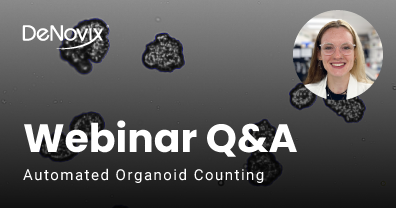Webinar Q&A
During our webinar Automated Organoid Counting with the DeNovix CellDrop Automated Cell Counter, we conducted a live question and answer session with our applications team. This post contains the questions answered by DeNovix scientists during the webinar.
The Count Tab is a live preview of the field of view, so you are able to see if there is any debris or lint left behind. We also have compatible slides that can be used with our Slide Mode. However, remember that disposable slides use the traditional 100 µm chamber height, which may not be able to accommodate all of your organoid sample types. The chamber height for CellDrop is set at 200 µm for counting organoids.
Our dynamic range of organoid size would be 4 – 400 µm in diameter. You can also gate out certain diameters after counting in the Result Tab.
The algorithm is brightfield-based with no assays or additional reagents required. You can simply take a sample from media and load it on the CellDrop for counting.
The Organoid app is specific to the CellDrop FLi model. If you have that model, then the app can be purchased and used without any modifications. If you have any other model, we do have upgrade paths available. If you’re interested in learning how to get the Organoids app in your lab, please contact our team and we’ll walk you through the options.
CellDrop has 21 CFR Part 11 compliance-ready software and IQ-OQ packages available for purchase.
Yes. The percent dissociated cells data serves as a QC step for the overall health of your sample. With the % dissociated cells, you can get an idea of how many of your cells are no longer maintained in organoid structures. An abundance of dissociated cells in the sample may indicate compromised organoid integrity, as healthy cells are normally maintained within established 3D structures.
The minimum amount of volume is 20 µL for the 200 µm chamber height. The 200 µm chamber height is the minimum due to the size of the organoids—we want to make sure that the structures can pass through the chamber.
No, you do not need to train the algorithm with your samples. Our scientists did all the training already using many different sample types. When you use the app in your lab, you are using a completed algorithm that does not require any additional training. You just load the sample and press count.
It is not required to create custom protocols for different organoid types, although it is an option we have available. You are able to use the default protocol for all of your counts if you desire.
Yes, we have LIMS compatible export formats available. You can also export raw .png images if you would like to use additional analysis software, such as ImageJ analysis.
In our webinar live demo, we pulled the sample directly from the flask. There is no additional sample preparation needed for this workflow.
Can you adjust the chamber height in the Organoids app to count objects that are bigger than 200 µm?
Yes, you can count objects that are bigger than 200 µm. To achieve this, you would create a custom protocol that uses the 400 µm chamber height and requires 40 µL of sample. The chamber height will adjust accordingly, and that would allow you to accommodate larger objects up to the recommended maximum of 400 nm.
If you have the same sample aliquot on the sample surfaces and keep going back to do another count without changing anything, you’re going to get the same results. If you’re pulling from the same aliquot, pipetting up and down lightly between each count, cleaning the sample surfaces, and loading a new aliquot, there will be great reproducibility between measurements.
The two groups that we provide counts for are dissociated cells and organoids. Dissociated cells include anything that would not be considered an organoid, such as dissociated parts of an organoid or single cells. Then we have the organoid group, including organoids identified by our machine learning algorithm. This data is all exportable too, so you can view the results in an Excel spreadsheet or something similar.
We used a wide variety of samples when training our algorithm. Some were very dense and had a lot of clumping, and others were very sparse. Because we trained the algorithm on these different densities and concentrations, we are able to accommodate those clumpy and highly concentrated samples.
Sometimes when debris is not in the correct focal plane, such as higher or lower in the focal plane, it might give the illusion of being a cell, but all intact cells sink to the lower surface quickly.
Our training included many different sample types. Depending on how viscous your sample is, that might affect the pipetting and ability to have the sample flow evenly across the field of view. But if it’s able to be pipetted, it’s definitely worth a try.
Correct. Any cellular structure that is not maintained in an organoid structure will be counted as dissociated cells.
8-AUG-2025



